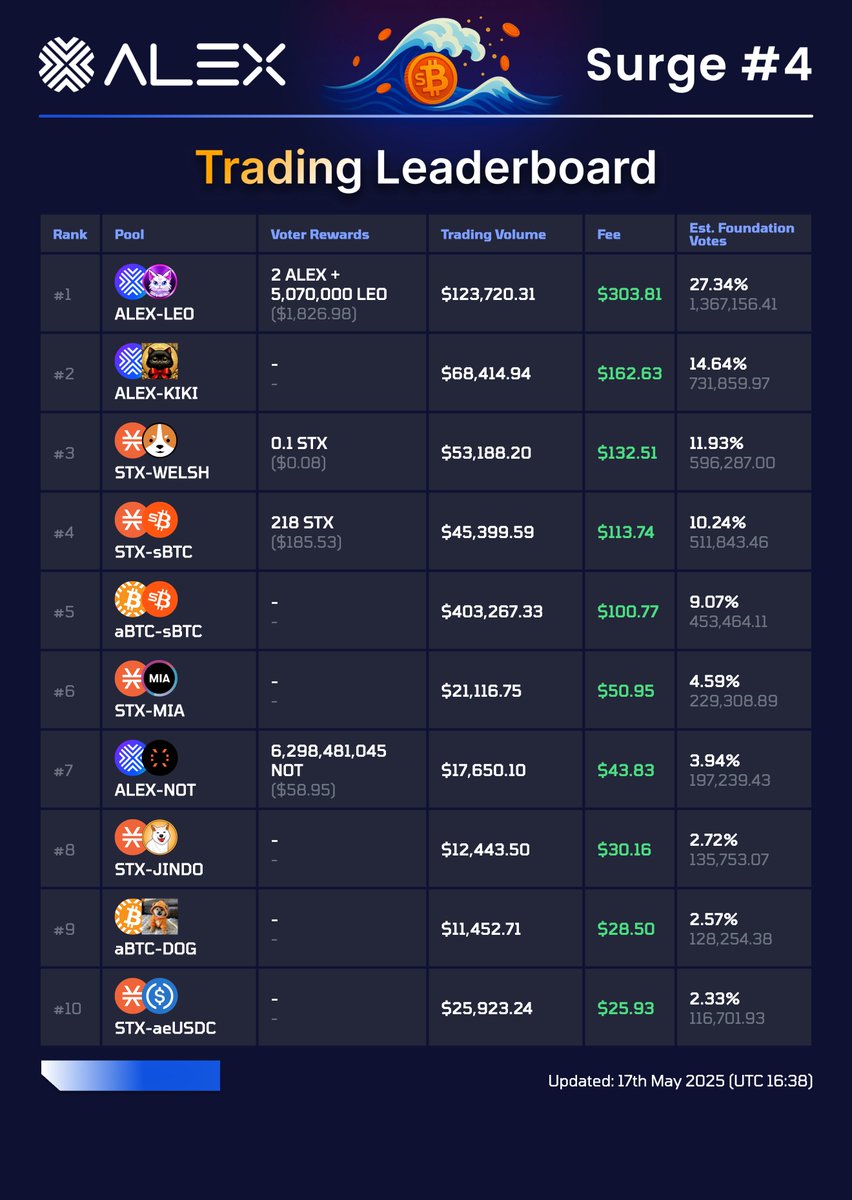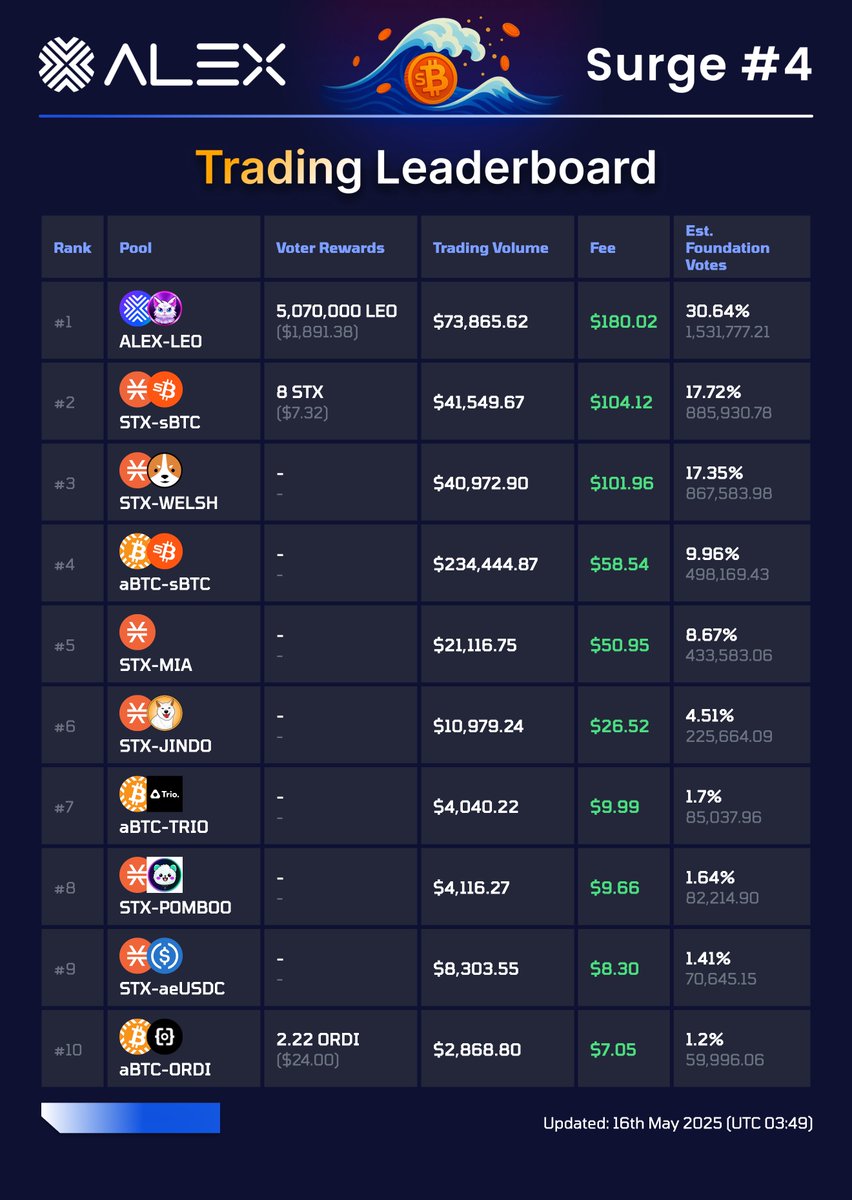This token isn’t available on the OKX Exchange. You can trade it on OKX DEX instead.

ABTC
ABTC price

6SLkv6...R2tK
$0.00066125
-$0.00002
(-2.55%)
Price change for the last 24 hours

How are you feeling about ABTC today?
Share your sentiments here by giving a thumbs up if you’re feeling bullish about the coin or a thumbs down if you’re feeling bearish.
Vote to view results
ABTC market info
Market cap
Market cap is calculated by multiplying the circulating supply of a coin with its latest price.
Market cap = Circulating supply × Last price
Market cap = Circulating supply × Last price
Network
Underlying blockchain that supports secure, decentralized transactions.
Circulating supply
Total amount of a coin that is publicly available on the market.
Liquidity
Liquidity is the ease of buying/selling a coin on DEX. The higher the liquidity, the easier it is to complete a transaction.
Market cap
$661,252.11
Network
Solana
Circulating supply
1,000,000,000 ABTC
Token holders
103
Liquidity
$71,097.84
1h volume
$2.20M
4h volume
$2.20M
24h volume
$2.20M
ABTC Feed
The following content is sourced from .

TechFlow
Words: Ashley
In 2025, the crypto industry is moving from the fringes to the mainstream, and the U.S. capital market takes center stage in this craze. From crypto fintech company Antalpha's stock price soaring 70% on its first day of listing and triggering a circuit breaker, to the world's leading exchange Coinbase's imminent entry into the S&P 500, to the backdoor listing of Bitcoin mining company American Bitcoin, which caused its stock price to soar, a wave of crypto companies have ignited investors' enthusiasm through initial public offerings (IPOs) or backdoor listings.
At the same time, Wall Street giants such as Morgan Stanley, Bank of America, and Royal Bank of Canada have smelled business opportunities and are trying to get a piece of the pie against the backdrop of the Trump administration's strong support for the crypto industry. The latest forecast from crypto asset manager Bitwise adds fuel to the frenzy, declaring that 2025 will be the "year of crypto IPOs", and that companies like Circle and Kraken are poised to take off. This wave not only demonstrates the maturity of the crypto industry, but also injects fresh blood into the capital market.
Crypto companies are listed in the U.S. stock market
Antalpha, a fintech company focused on crypto asset management, trading, and infrastructure services, was officially launched on the NASDAQ Global Market on May 14 under the ticker symbol "ANTA". On the first day of listing, Antalpha's stock price jumped 70% like a rocket, triggering a circuit breaker mechanism and finally closing with a daily limit. This debut not only made investors excited, but also marked Antalpha's successful step from a crypto professional into the spotlight of traditional finance.
At the same time, Coinbase, the "big brother" of the crypto exchange, also ushered in a highlight moment. Coinbase will soon be included in the S&P 500 index, becoming the first crypto company to receive this honor. This is not only an affirmation of Coinbase, but also a milestone recognition of the mainstreaming process of the entire crypto industry. The S&P 500 brings together the top players in the U.S. economy, and Coinbase's inclusion means that crypto assets are being embraced by the traditional financial system. Market analyst firm QCP Capital excitedly predicts that this event may become a new "tipping point" for the crypto market, attracting more institutional investors and pushing the price of assets such as bitcoin to new highs. Back in 2021, Coinbase's direct listing was handled by top investment banks such as Goldman Sachs and JPMorgan Chase, and now its S&P 500 status has cemented its position as an industry leader.
In addition to direct IPOs, backdoor listings have become a "fast lane" for many crypto companies to knock on the door to the open market. Among them, the case of Trump's son Bitcoin mining company American Bitcoin is textbook-level. American Bitcoin, a subsidiary of mining giant Hut 8, plans to list on the NASDAQ under the ticker symbol "ABTC" through a merger with Gryphon Digital Mining. The deal, which was in the spotlight due to the Trump family's endorsement, saw Gryphon Digital Mining's share price soar 330% on the news. Asher Geneot, CEO of Hut 8, said that the listing is "the next big step in accumulating Bitcoin at low cost", with the goal of creating a "Bitcoin bank". This not only demonstrates the flexibility of backdoor listings, but also highlights the influence of political context in the crypto industry.
Another player, Galaxy Digital, is not to be outdone. The crypto asset manager plans to list on the Nasdaq on May 16 and is currently awaiting final approval from a shareholder meeting. Galaxy Digital's business spans trading, investing, and advisory, and is committed to providing crypto financial services to institutional and high-net-worth clients. However, its financial report of a loss of $295 million in the first quarter of 2025 poured cold water on investors. Despite this, the market remains optimistic about its listing prospects, and investors are excited about its long-term potential.
In addition, Amber International has further enriched the public market landscape of crypto companies by merging and listing on the NASDAQ under the ticker symbol "AMBR". Companies such as Gemini (a crypto platform backed by the Winklevoss twin), Bullish (an exchange endorsed by Peter Thiel), Circle Internet Financial, and Kraken have also been rumored to have IPO plans, which could happen as early as 2025.
Going both ways?
Behind the listing boom, there is not only the endogenous momentum of the crypto industry, but also the strong entry of Wall Street giants. For a long time, traditional financial institutions have taken a wait-and-see attitude towards the crypto market, with high risks and regulatory pressures holding them back. However, the Trump administration's rise to power has completely changed the rules of the game. Trump, the self-proclaimed "crypto president," pledged to make the United States the "global crypto capital," quickly signed an executive order on digital assets after taking office, and pushed the SEC to establish a crypto task force led by industry advocate Hester Peirce. David Sacks, the head of crypto affairs at the White House, is even studying the feasibility of creating a national bitcoin reserve. These policies are like a shot in the arm, clearing the way for crypto companies to go public, and also igniting the enthusiasm of Wall Street.
Morgan Stanley is at the vanguard of this change. According to people familiar with the matter, the investment bank, which had previously kept a low profile in the crypto space, is actively reaching out to potential customers and is eager to handle the IPO of crypto companies. In 2024, Morgan Stanley assisted Coinbase in its issuance of convertible bonds and was hired by IREN to explore monetization opportunities in the AI data market. Now, it's gearing up to hit the IPO craze. Bank of America is not far behind, and its investment banking executives are talking about how to push the digital asset trading business and target the tens of billions of dollars in fee cake in this market. CEO Brian Moynihan said in an interview with CNBC in early 2025 that banks would be "all in" in the trading space once regulatory clarity became clear.
The Royal Bank of Canada (RBC) is also racing fast. At the end of 2024, RBC assisted crypto mining company Core Scientific in the issuance of convertible bonds, and data from its official website shows a surge in market activity among crypto issuers since the 2024 U.S. election. RBC started late, but it is cautiously accelerating its deployment. In addition, investment banks such as Jefferies Financial Group, Moelis & Co., and Cantor Fitzgerald have also made their mark in crypto trading. For example, Jefferies is advising JPMorgan Chase on a potential IPO for Bullish and assisting Figure Technologies in preparing for its IPO. Even HSBC has quietly moved on with the addition of the title of "Head of Digital Asset Research" to its senior FX strategist, indicating that traditional finance's interest in the crypto space is heating up across the board.
What is the reason for the "big year of crypto IPOs"?
The crypto industry is maturing. After more than a decade of ups and downs, cryptocurrencies have grown from speculative assets that "grew wildly" to become an important member of the global financial system. The successful listing of Coinbase in the S&P 500 and Antalpha shows a significant increase in the acceptance of crypto companies by traditional finance. Going public not only allows companies to gain credibility, but also introduces more institutional capital to the industry.
Bitwise's latest forecast boldly asserts that 2025 will be the "year of crypto IPOs," pointing to three major engines driving this trend: active participation from regulators, support from institutional investors, and strong demand from market investors.
First, an improvement in the regulatory environment is key. In the past, heavy scrutiny by the SEC has put many IPO plans on hold, and banks have been asked to suspend crypto activity. Typically, companies make their S-1 documents public 6 to 8 months after the draft is filed, but the complexity of the crypto industry makes the process uncertain. The Trump administration's pro-crypto policies have given businesses the green light, and the SEC's newly formed crypto task force is expected to accelerate approvals, paving the way for IPOs by companies such as Circle, Kraken, Figure, Anchorage, and Chainalysis.
Second, the need for financing is the core driver. Crypto companies often need huge amounts of capital, such as mining companies purchasing expensive ASIC mining rigs, exchanges upgrading technology platforms, and asset managers developing new products. Going public provides a direct source of financing for companies to navigate market volatility and accelerate expansion. For example, American Bitcoin plans to expand its mining business through private financing, while Galaxy Digital hopes to ease financial pressure through listing.
Finally, the enthusiasm of investors has injected a strong impetus into the boom. The entry of Wall Street giants shows that crypto is no longer on the fringes as it used to be. The strategic pivot of Morgan Stanley and Bank of America, as well as the active performance of Goldman Sachs and JPMorgan Chase in Coinbase and Bullish trading, all show the growing confidence of institutions in crypto companies. This support not only provides professional financial services for enterprises, but also attracts more institutional capital into the market. Antalpha's first-day limit and Gryphon Digital Mining's share price skyrocketed, demonstrating the market's pursuit of crypto companies. Sol Strategies and Exodus are planning to list on the Nasdaq and NYSE U.S. markets, respectively, further fueling investor enthusiasm. Bitwise noted that more crypto listings will attract retail investors to participate in the industry through the stock market without having to hold crypto assets directly, which will rebuild trust and free up huge capital.
Crypto wants to be mainstreamed, but does it really have an impact on the price of the currency?
In the long run, this listing boom will accelerate the mainstreaming of the crypto industry. Coinbase's S&P 500 status, Antalpha's successful listing, Wall Street's entry, and Bitwise's "Year of Crypto IPOs" predictions are signs that crypto assets are being integrated into traditional portfolios and move away from the "speculative" label. As more companies go public, the industry will attract more institutional and retail funds, and the market size will further expand. Bitwise points out that listed companies will lower the barrier to entry for investors through the stock market, enhancing transparency and trust.
At the same time, the boom will intensify competition in the industry. Exchanges, mining companies, and asset managers will race to innovate with lower transaction fees, more efficient mining techniques, or richer financial products. This kind of competition will benefit consumers and enhance the competitiveness of the industry. The professional management of Wall Street will also promote the standardization of the market.
Globally, the IPO boom in the United States could trigger a chain reaction, incentivizing crypto companies in Canada, Europe and other regions to follow suit and form a global crypto capital market. This will drive the globalization of the industry and provide more opportunities for investors.
This listing boom will profoundly reshape the crypto market, bringing both opportunities and risks. On the positive side, the boom has greatly boosted market confidence. Coinbase's S&P 500 status signals the maturity of the industry and could attract more traditional investors to the market, driving crypto asset prices higher. The IPO plans of Antalpha, Amber International, Gemini, and others are a testament to the attractiveness of crypto companies in the public market. Bitwise emphasized that the open market will force companies to disclose more financial data, increase transparency, and restore investor trust.
In addition, the boom will drive industry consolidation. Backdoor listings provide SMEs with a shortcut to the public market and lower the IPO threshold. American Bitcoin, for example, quickly achieved its listing goal through a merger. This model may encourage more companies to follow suit, accelerate resource integration, and optimize the market structure. The participation of Wall Street investment banks will also enhance the professionalism of transactions and inject more capital into the industry.
Advances in technology and infrastructure will also benefit from the boom. Listed companies can invest in technological innovation after receiving funds. For example, Hut 8 is partnering with Bitmain to develop efficient mining equipment, Coinbase is upgrading its trading platform, and Galaxy Digital may launch new financial products. These initiatives will drive technological advancement in the industry and enhance the user experience.
However, the risks should not be overlooked. First of all, financial volatility is a concern. Galaxy Digital posted a loss of $295 million in the first quarter, exposing the vulnerability of crypto businesses to market volatility. High valuations can create bubbles, and stock prices can plummet once investor confidence is shaken. Second, regulatory uncertainty remains. Despite the current policy easing, future regulatory changes are likely to impact listed companies, especially under SEC scrutiny. Finally, market speculation overheating can exacerbate volatility. Gryphon Digital Mining's 330% jump in stock price highlights the speculative nature that could lead to market instability.
Show original


3.68K
1

Odaily
In 2025, the crypto industry is moving from the fringes to the mainstream, and the U.S. capital market takes center stage in this craze. From crypto fintech company Antalpha's stock price soaring 70% on its first day of listing and triggering a circuit breaker, to the world's leading exchange Coinbase's imminent entry into the S&P 500, to the backdoor listing of Bitcoin mining company American Bitcoin, which caused the stock price to soar, a wave of crypto companies have ignited investors' enthusiasm through initial public offerings (IPOs) or backdoor listings.
At the same time, Wall Street giants such as Morgan Stanley, Bank of America, and Royal Bank of Canada have smelled business opportunities and are trying to get a piece of the pie against the backdrop of the Trump administration's strong support for the crypto industry. The latest forecast from crypto asset manager Bitwise adds fuel to the frenzy, declaring that 2025 will be the "year of crypto IPOs", and that companies like Circle and Kraken are poised to take off. This wave not only demonstrates the maturity of the crypto industry, but also injects fresh blood into the capital market.
Crypto companies are listed in the U.S. stock market
Antalpha, a fintech company focused on crypto asset management, trading, and infrastructure services, was officially launched on the NASDAQ Global Market on May 14 under the ticker symbol "ANTA". On the first day of listing, Antalpha's stock price jumped 70% like a rocket, triggering the circuit breaker mechanism and finally closing with a daily limit. This debut not only made investors excited, but also marked Antalpha's successful step from a crypto professional into the spotlight of traditional finance.
At the same time, Coinbase, the "big brother" of the crypto exchange, also ushered in a highlight moment. Coinbase will soon be included in the S&P 500 index, becoming the first crypto company to receive this honor. This is not only an affirmation of Coinbase, but also a milestone recognition of the mainstreaming process of the entire crypto industry. The S&P 500 brings together the top players in the U.S. economy, and Coinbase's inclusion means that crypto assets are being embraced by the traditional financial system. Market analyst firm QCP Capital excitedly predicts that this event may become a new "tipping point" for the crypto market, attracting more institutional investors and pushing the price of assets such as bitcoin to new highs. Back in 2021, Coinbase's direct listing was handled by top investment banks such as Goldman Sachs and JPMorgan Chase, and now its S&P 500 status has cemented its position as an industry leader.
In addition to direct IPOs, backdoor listings have become a "fast lane" for many crypto companies to knock on the door to the open market. Among them, the case of Trump's son Bitcoin mining company American Bitcoin can be called textbook. American Bitcoin, a subsidiary of mining giant Hut 8, plans to list on the NASDAQ under the ticker symbol "ABTC" through a merger with Gryphon Digital Mining. The deal was in the spotlight due to the Trump family's endorsement, and Gryphon Digital Mining's stock price skyrocketed 330% on the news. Asher Geneot, CEO of Hut 8, said that the listing is "the next big step in accumulating Bitcoin at low cost", with the goal of creating a "Bitcoin bank". This not only demonstrates the flexibility of backdoor listings, but also highlights the influence of political context in the crypto industry.
Another player, Galaxy Digital, is not to be outdone. The crypto asset manager plans to list on the Nasdaq on May 16 and is currently awaiting final approval from a shareholder meeting. Galaxy Digital's business spans trading, investing, and advisory, and is committed to providing crypto financial services to institutional and high-net-worth clients. However, its financial report of a loss of $295 million in the first quarter of 2025 poured cold water on investors. Despite this, the market remains optimistic about its listing prospects, and investors are excited about its long-term potential.
In addition, Amber International has further enriched the public market landscape of crypto companies by merging and listing on the NASDAQ under the ticker symbol "AMBR". Companies such as Gemini (a crypto platform backed by the Winklevoss twin), Bullish (an exchange endorsed by Peter Thiel), Circle Internet Financial, and Kraken have also been rumored to have IPO plans, which could happen as early as 2025.
Going both ways?
Behind the listing boom, there is not only the endogenous momentum of the crypto industry, but also the strong entry of Wall Street giants. For a long time, traditional financial institutions have taken a wait-and-see attitude towards the crypto market, with high risks and regulatory pressures holding them back. However, the Trump administration's rise to power has completely changed the rules of the game. Trump, the self-proclaimed "crypto president," pledged to make the United States the "global crypto capital," quickly signed an executive order on digital assets after taking office, and pushed the SEC to establish a crypto task force led by industry advocate Hester Peirce. David Sacks, the head of crypto affairs at the White House, is even studying the feasibility of creating a national bitcoin reserve. These policies are like a shot in the arm, clearing the way for crypto companies to go public, and also igniting the enthusiasm of Wall Street.
Morgan Stanley is at the vanguard of this change. According to people familiar with the matter, the investment bank, which had previously kept a low profile in the crypto space, is actively reaching out to potential customers and is eager to handle the IPO of crypto companies. In 2024, Morgan Stanley assisted Coinbase in its issuance of convertible bonds and was hired by IREN to explore monetization opportunities in the AI data market. Now, it's gearing up to hit the IPO craze. Bank of America is not far behind, and its investment banking executives are talking about how to push the digital asset trading business and target the tens of billions of dollars in fee cake in this market. CEO Brian Moynihan said in an interview with CNBC in early 2025 that banks would be "all in" in the trading space once regulatory clarity became clear.
The Royal Bank of Canada (RBC) is also racing fast. At the end of 2024, RBC assisted crypto mining company Core Scientific in the issuance of convertible bonds, and data from its official website shows a surge in market activity among crypto issuers since the 2024 U.S. election. RBC started late, but it is cautiously accelerating its deployment. In addition, investment banks such as Jefferies Financial Group, Moelis & Co., and Cantor Fitzgerald have also made their mark in crypto trading. For example, Jefferies is advising JPMorgan Chase on a potential IPO for Bullish and assisting Figure Technologies in preparing for its IPO. Even HSBC has quietly moved on with the addition of the title of "Head of Digital Asset Research" to its senior FX strategist, indicating that traditional finance's interest in the crypto space is heating up across the board.
What is the reason for the "big year of crypto IPOs"?
The crypto industry is maturing. After more than a decade of ups and downs, cryptocurrencies have grown from speculative assets that "grew wildly" to become an important member of the global financial system. The successful listing of Coinbase in the S&P 500 and Antalpha shows a significant increase in the acceptance of crypto companies by traditional finance. Going public not only allows companies to gain credibility, but also introduces more institutional capital to the industry.
Bitwise's latest forecast boldly asserts that 2025 will be the "year of crypto IPOs," pointing to three major engines driving this trend: active participation from regulators, support from institutional investors, and strong demand from market investors.
First, an improvement in the regulatory environment is key. In the past, heavy scrutiny by the SEC has put many IPO plans on hold, and banks have been asked to suspend crypto activity. Typically, companies make their S-1 documents public 6 to 8 months after the draft is filed, but the complexity of the crypto industry makes the process uncertain. The Trump administration's pro-crypto policies have given businesses the green light, and the SEC's newly formed crypto task force is expected to accelerate approvals, paving the way for IPOs by companies such as Circle, Kraken, Figure, Anchorage, and Chainalysis.
Second, the need for financing is the core driver. Crypto companies often need huge amounts of capital, such as mining companies purchasing expensive ASIC mining rigs, exchanges upgrading technology platforms, and asset managers developing new products. Going public provides a direct source of financing for companies to navigate market volatility and accelerate expansion. For example, American Bitcoin plans to expand its mining business through private financing, while Galaxy Digital hopes to ease financial pressure through listing.
Finally, the enthusiasm of investors has injected a strong impetus into the boom. The entry of Wall Street giants shows that crypto is no longer on the fringes as it used to be. The strategic pivot of Morgan Stanley and Bank of America, as well as the active performance of Goldman Sachs and JPMorgan Chase in Coinbase and Bullish trading, all show the growing confidence of institutions in crypto companies. This support not only provides professional financial services for enterprises, but also attracts more institutional capital into the market. Antalpha's first-day limit and Gryphon Digital Mining's share price skyrocketed, demonstrating the market's pursuit of crypto companies. Sol Strategies and Exodus are planning to list on the Nasdaq and NYSE U.S. markets, respectively, further fueling investor enthusiasm. Bitwise noted that more crypto listings will attract retail investors to participate in the industry through the stock market without having to hold crypto assets directly, which will rebuild trust and free up huge capital.
Crypto wants to be mainstreamed, but does it really have an impact on the price of the currency?
In the long run, this listing boom will accelerate the mainstreaming of the crypto industry. Coinbase's S&P 500 status, Antalpha's successful listing, Wall Street's entry, and Bitwise's "Year of Crypto IPOs" predictions are signs that crypto assets are being integrated into traditional portfolios and move away from the "speculative" label. As more companies go public, the industry will attract more institutional and retail funds, and the market size will further expand. Bitwise points out that listed companies will lower the barrier to entry for investors through the stock market, enhancing transparency and trust.
At the same time, the boom will intensify competition in the industry. Exchanges, mining companies, and asset managers will race to innovate with lower transaction fees, more efficient mining techniques, or richer financial products. This kind of competition will benefit consumers and enhance the competitiveness of the industry. The professional management of Wall Street will also promote the standardization of the market.
Globally, the IPO boom in the United States could trigger a chain reaction, incentivizing crypto companies in Canada, Europe and other regions to follow suit and form a global crypto capital market. This will drive the globalization of the industry and provide more opportunities for investors.
This listing boom will profoundly reshape the crypto market, bringing both opportunities and risks. On the positive side, the boom has greatly boosted market confidence. Coinbase's S&P 500 status signals the maturity of the industry and could attract more traditional investors to the market, driving crypto asset prices higher. The IPO plans of Antalpha, Amber International, Gemini, and others are a testament to the attractiveness of crypto companies in the public market. Bitwise emphasized that the open market will force companies to disclose more financial data, increase transparency, and restore investor trust.
In addition, the boom will drive industry consolidation. Backdoor listings provide SMEs with a shortcut to the public market and lower the IPO threshold. American Bitcoin, for example, quickly achieved its listing goal through a merger. This model may encourage more companies to follow suit, accelerate resource integration, and optimize the market structure. The participation of Wall Street investment banks will also enhance the professionalism of transactions and inject more capital into the industry.
Advances in technology and infrastructure will also benefit from the boom. Listed companies can invest in technological innovation after receiving funds. For example, Hut 8 is partnering with Bitmain to develop efficient mining equipment, Coinbase is upgrading its trading platform, and Galaxy Digital may launch new financial products. These initiatives will drive technological advancement in the industry and enhance the user experience.
However, the risks should not be overlooked. First of all, financial volatility is a concern. Galaxy Digital posted a loss of $295 million in the first quarter, exposing the vulnerability of crypto businesses to market volatility. High valuations can create bubbles, and stock prices can plummet once investor confidence is shaken. Second, regulatory uncertainty remains. Despite the current policy easing, future regulatory changes are likely to impact listed companies, especially under SEC scrutiny. Finally, market speculation overheating can exacerbate volatility. Gryphon Digital Mining's 330% jump in stock price highlights the speculative nature that could lead to market instability.
Show original


4.43K
0

Blockbeats
In 2025, the crypto industry is moving from the fringes to the mainstream, and the U.S. capital market takes center stage in this craze. From the 70% surging in the first day of listing of crypto fintech company Antalpha and triggering a circuit breaker, to the imminent entry of Coinbase, the world's leading exchange, to the soaring stock price caused by the backdoor listing of Bitcoin mining company American Bitcoin, a wave of crypto companies have ignited investors' enthusiasm through initial public offerings (IPOs) or backdoor listings.
At the same time, Wall Street giants such as Morgan Stanley, Bank of America, and Royal Bank of Canada have smelled business opportunities and are trying to get a piece of the pie against the backdrop of the Trump administration's strong support for the crypto industry. The latest forecast from crypto asset manager Bitwise adds fuel to the frenzy, declaring that 2025 will be the "year of crypto IPOs", and that companies like Circle and Kraken are poised to take off. This wave not only demonstrates the maturity of the crypto industry, but also injects fresh blood into the capital market.
Crypto companies are listed in the U.S. stock market
Antalpha, a fintech company focused on crypto asset management, trading, and infrastructure services, was officially launched on the NASDAQ Global Market on May 14 under the ticker symbol "ANTA". On the first day of listing, Antalpha's stock price jumped 70% like a rocket, triggering a circuit breaker mechanism and finally closing with a daily limit. This debut not only made investors excited, but also marked Antalpha's successful step from a crypto professional into the spotlight of traditional finance.
At the same time, Coinbase, the "big brother" of the crypto exchange, also ushered in a highlight moment. Coinbase will soon be included in the S&P 500 index, becoming the first crypto company to receive this honor. This is not only an affirmation of Coinbase, but also a milestone recognition of the mainstreaming process of the entire crypto industry. The S&P 500 brings together the top players in the U.S. economy, and Coinbase's inclusion means that crypto assets are being embraced by the traditional financial system. Market analyst firm QCP Capital excitedly predicts that this event may become a new "tipping point" for the crypto market, attracting more institutional investors and pushing the price of assets such as bitcoin to new highs. Back in 2021, Coinbase's direct listing was handled by top investment banks such as Goldman Sachs and JPMorgan Chase, and now its S&P 500 status has cemented its position as an industry leader.
In addition to direct IPOs, backdoor listings have become a "fast lane" for many crypto companies to knock on the door to the open market. Among them, the case of Trump's son Bitcoin mining company American Bitcoin can be called textbook. American Bitcoin, a subsidiary of mining giant Hut 8, plans to list on the NASDAQ under the ticker symbol "ABTC" through a merger with Gryphon Digital Mining. The deal, which was in the spotlight due to the Trump family's endorsement, saw Gryphon Digital Mining's share price soar 330% on the news. Asher Geneot, CEO of Hut 8, said that the listing is "the next big step in accumulating Bitcoin at low cost", with the goal of creating a "Bitcoin bank". This not only demonstrates the flexibility of backdoor listings, but also highlights the influence of political context in the crypto industry.
Another player, Galaxy Digital, is not to be outdone. The crypto asset manager plans to list on the Nasdaq on May 16 and is currently awaiting final approval from a shareholder meeting. Galaxy Digital's business spans trading, investing, and advisory, and is committed to providing crypto financial services to institutional and high-net-worth clients. However, its financial report of a loss of $295 million in the first quarter of 2025 poured cold water on investors. Despite this, the market remains optimistic about its listing prospects, and investors are excited about its long-term potential.
In addition, Amber International has further enriched the public market landscape of crypto companies by merging and listing on the NASDAQ under the ticker symbol "AMBR". Companies such as Gemini (a crypto platform backed by the Winklevoss twin), Bullish (an exchange endorsed by Peter Thiel), Circle Internet Financial, and Kraken have also been rumored to have IPO plans, which could happen as early as 2025.
Going both ways?
Behind the listing boom, there is not only the endogenous momentum of the crypto industry, but also the strong entry of Wall Street giants. For a long time, traditional financial institutions have taken a wait-and-see attitude towards the crypto market, with high risks and regulatory pressures holding them back. However, the Trump administration's rise to power has completely changed the rules of the game. Trump, the self-proclaimed "crypto president," pledged to make the United States the "global crypto capital," quickly signed an executive order on digital assets after taking office, and pushed the SEC to establish a crypto task force led by industry advocate Hester Peirce. David Sacks, the head of crypto affairs at the White House, is even studying the feasibility of creating a national bitcoin reserve. These policies are like a shot in the arm, clearing the way for crypto companies to go public, and also igniting the enthusiasm of Wall Street.
Morgan Stanley is at the vanguard of this change. According to people familiar with the matter, the investment bank, which had previously kept a low profile in the crypto space, is actively reaching out to potential customers and is eager to handle the IPO of crypto companies. In 2024, Morgan Stanley assisted Coinbase in its issuance of convertible bonds and was hired by IREN to explore monetization opportunities in the AI data market. Now, it's gearing up to hit the IPO craze. Bank of America is not far behind, and its investment banking executives are talking about how to push the digital asset trading business and target the tens of billions of dollars in fee cake in this market. CEO Brian Moynihan said in an interview with CNBC in early 2025 that banks would be "all in" in the trading space once regulatory clarity became clear.
The Royal Bank of Canada (RBC) is also racing fast. At the end of 2024, RBC assisted crypto mining company Core Scientific in the issuance of convertible bonds, and data from its official website shows a surge in market activity among crypto issuers since the 2024 U.S. election. RBC started late, but it is cautiously accelerating its deployment. In addition, investment banks such as Jefferies Financial Group, Moelis & Co., and Cantor Fitzgerald have also made their mark in crypto trading. For example, Jefferies is advising JPMorgan Chase on a potential IPO for Bullish and assisting Figure Technologies in preparing for its IPO. Even HSBC has quietly moved on with the addition of the title of "Head of Digital Asset Research" to its senior FX strategist, indicating that traditional finance's interest in the crypto space is heating up across the board.
What is the reason for the "big year of crypto IPOs"?
The crypto industry is maturing. After more than a decade of ups and downs, cryptocurrencies have grown from speculative assets that "grew wildly" to become an important member of the global financial system. The successful listing of Coinbase in the S&P 500 and Antalpha shows a significant increase in the acceptance of crypto companies by traditional finance. Going public not only allows companies to gain credibility, but also introduces more institutional capital to the industry.
Bitwise's latest forecast boldly asserts that 2025 will be the "year of crypto IPOs," pointing to three major engines driving this trend: active participation from regulators, support from institutional investors, and strong demand from market investors.
First, an improvement in the regulatory environment is key. In the past, heavy scrutiny by the SEC has put many IPO plans on hold, and banks have been asked to suspend crypto activity. Typically, companies make their S-1 documents public 6 to 8 months after the draft is filed, but the complexity of the crypto industry makes the process uncertain. The Trump administration's pro-crypto policies have given businesses the green light, and the SEC's newly formed crypto task force is expected to accelerate approvals, paving the way for IPOs by companies such as Circle, Kraken, Figure, Anchorage, and Chainalysis.
Second, the need for financing is the core driver. Crypto companies often need huge amounts of capital, such as mining companies purchasing expensive ASIC mining rigs, exchanges upgrading technology platforms, and asset managers developing new products. Going public provides a direct source of financing for companies to navigate market volatility and accelerate expansion. For example, American Bitcoin plans to expand its mining business through private financing, while Galaxy Digital hopes to ease financial pressure through listing.
Finally, the enthusiasm of investors has injected a strong impetus into the boom. The entry of Wall Street giants shows that crypto is no longer on the fringes as it used to be. The strategic pivot of Morgan Stanley and Bank of America, as well as the active performance of Goldman Sachs and JPMorgan Chase in Coinbase and Bullish trading, all show the growing confidence of institutions in crypto companies. This support not only provides professional financial services for enterprises, but also attracts more institutional capital into the market. Antalpha's first-day limit and Gryphon Digital Mining's share price skyrocketed, demonstrating the market's pursuit of crypto companies. Sol Strategies and Exodus are planning to list on the Nasdaq and NYSE U.S. markets, respectively, further fueling investor enthusiasm. Bitwise noted that more crypto listings will attract retail investors to participate in the industry through the stock market without having to hold crypto assets directly, which will rebuild trust and free up huge capital.
Crypto wants to be mainstreamed, but does it really have an impact on the price of the currency?
In the long run, this listing boom will accelerate the mainstreaming of the crypto industry. Coinbase's S&P 500 status, Antalpha's successful listing, Wall Street's entry, and Bitwise's "Year of Crypto IPOs" predictions are signs that crypto assets are being integrated into traditional portfolios and move away from the "speculative" label. As more companies go public, the industry will attract more institutional and retail funds, and the market size will further expand. Bitwise points out that listed companies will lower the barrier to entry for investors through the stock market, enhancing transparency and trust.
At the same time, the boom will intensify competition in the industry. Exchanges, mining companies, and asset managers will race to innovate with lower transaction fees, more efficient mining techniques, or richer financial products. This kind of competition will benefit consumers and enhance the competitiveness of the industry. The professional management of Wall Street will also promote the standardization of the market.
Globally, the IPO boom in the United States could trigger a chain reaction, incentivizing crypto companies in Canada, Europe and other regions to follow suit and form a global crypto capital market. This will drive the globalization of the industry and provide more opportunities for investors.
This listing boom will profoundly reshape the crypto market, bringing both opportunities and risks. On the positive side, the boom has greatly boosted market confidence. Coinbase's S&P 500 status signals the maturity of the industry and could attract more traditional investors to the market, driving crypto asset prices higher. The IPO plans of Antalpha, Amber International, Gemini, and others are a testament to the attractiveness of crypto companies in the public market. Bitwise emphasized that the open market will force companies to disclose more financial data, increase transparency, and restore investor trust.
In addition, the boom will drive industry consolidation. Backdoor listings provide SMEs with a shortcut to the public market and lower the IPO threshold. American Bitcoin, for example, quickly achieved its listing goal through a merger. This model may encourage more companies to follow suit, accelerate resource integration, and optimize the market structure. The participation of Wall Street investment banks will also enhance the professionalism of transactions and inject more capital into the industry.
Advances in technology and infrastructure will also benefit from the boom. Listed companies can invest in technological innovation after receiving funds. For example, Hut 8 is partnering with Bitmain to develop efficient mining equipment, Coinbase is upgrading its trading platform, and Galaxy Digital may launch new financial products. These initiatives will drive technological advancement in the industry and enhance the user experience.
However, the risks should not be overlooked. First of all, financial volatility is a concern. Galaxy Digital posted a loss of $295 million in the first quarter, exposing the vulnerability of crypto businesses to market volatility. High valuations can create bubbles, and stock prices can plummet once investor confidence is shaken. Second, regulatory uncertainty remains. Despite the current policy easing, future regulatory changes are likely to impact listed companies, especially under SEC scrutiny. Finally, market speculation overheating can exacerbate volatility. Gryphon Digital Mining's 330% jump in stock price highlights the speculative nature that could lead to market instability.
Show original


6.15K
0

ALEX 🟧 No. 1 Bitcoin DeFi reposted

ALEX 🟧 No. 1 Bitcoin DeFi
🌊 Surge Registration Highlights 🌊
Day 3, Trading Leaderboard Top 5 🏆
1️⃣ $LEO 🥇
2️⃣ $KIKI 🥈
3️⃣ $WELSH 🥉
4️⃣ $STX - $sBTC
5️⃣ $aBTC - $sBTC
The board remains dynamic but the trend over the past day has been @LeoCoinSTX @Stacks_RichCat and @Welsh_Community in top 3, although @wrappednothing is starting to rise up the table 👀
See the board 👉
What to do now 👇
🔸 Register your pools to climb the Trading Leaderboard 📈
🔸 Trade to drive fees and boost your rank 🪙
🔸 Donate Voter Rewards to attract voters 💰
📅 Registration stage runs through May 29
Ride the Surge 🌊
Show original
39.26K
72

ALEX 🟧 No. 1 Bitcoin DeFi reposted

ALEX 🟧 No. 1 Bitcoin DeFi
🌊 Surge Registration Highlights 🌊
Day 1, Trading Leaderboard Top 5 🏆
1️⃣ $LEO 🥇
2️⃣ $WELSH 🥈
3️⃣ $STX - $sBTC 🥉
4️⃣ $aBTC - $sBTC
5️⃣ $MIA
Just over 12 hours in with +50 pools registered ⏳
The board is dynamic and shifts faster than we can post! 😆
See the board 👉
What to do 👇
🔸 Register your pools quickly to climb the Trading Leaderboard fast 📈
🔸 Trade to drive fees and boost your rank 🪙
🔸 Donate Voter Rewards to attract voters 💰
📅 Registration stage runs through May 29
Surge 4 is Live, Let's Go! 🌊
Show original
39.95K
42
ABTC price performance in USD
The current price of abtc is $0.00066125. Over the last 24 hours, abtc has decreased by -2.55%. It currently has a circulating supply of 1,000,000,000 ABTC and a maximum supply of 1,000,000,000 ABTC, giving it a fully diluted market cap of $661,252.11. The abtc/USD price is updated in real-time.
5m
-15.54%
1h
-2.55%
4h
-2.55%
24h
-2.55%
About ABTC (ABTC)
ABTC FAQ
What’s the current price of ABTC?
The current price of 1 ABTC is $0.00066125, experiencing a -2.55% change in the past 24 hours.
Can I buy ABTC on OKX?
No, currently ABTC is unavailable on OKX. To stay updated on when ABTC becomes available, sign up for notifications or follow us on social media. We’ll announce new cryptocurrency additions as soon as they’re listed.
Why does the price of ABTC fluctuate?
The price of ABTC fluctuates due to the global supply and demand dynamics typical of cryptocurrencies. Its short-term volatility can be attributed to significant shifts in these market forces.
How much is 1 ABTC worth today?
Currently, one ABTC is worth $0.00066125. For answers and insight into ABTC's price action, you're in the right place. Explore the latest ABTC charts and trade responsibly with OKX.
What is cryptocurrency?
Cryptocurrencies, such as ABTC, are digital assets that operate on a public ledger called blockchains. Learn more about coins and tokens offered on OKX and their different attributes, which includes live prices and real-time charts.
When was cryptocurrency invented?
Thanks to the 2008 financial crisis, interest in decentralized finance boomed. Bitcoin offered a novel solution by being a secure digital asset on a decentralized network. Since then, many other tokens such as ABTC have been created as well.
Monitor crypto prices on an exchange
Watch this video to learn about what happens when you move your money to a crypto exchange.
Disclaimer
The social content on this page ("Content"), including but not limited to tweets and statistics provided by LunarCrush, is sourced from third parties and provided "as is" for informational purposes only. OKX does not guarantee the quality or accuracy of the Content, and the Content does not represent the views of OKX. It is not intended to provide (i) investment advice or recommendation; (ii) an offer or solicitation to buy, sell or hold digital assets; or (iii) financial, accounting, legal or tax advice. Digital assets, including stablecoins and NFTs, involve a high degree of risk, can fluctuate greatly. The price and performance of the digital assets are not guaranteed and may change without notice.
OKX does not provide investment or asset recommendations. You should carefully consider whether trading or holding digital assets is suitable for you in light of your financial condition. Please consult your legal/tax/investment professional for questions about your specific circumstances. For further details, please refer to our Terms of Use and Risk Warning. By using the third-party website ("TPW"), you accept that any use of the TPW will be subject to and governed by the terms of the TPW. Unless expressly stated in writing, OKX and its affiliates (“OKX”) are not in any way associated with the owner or operator of the TPW. You agree that OKX is not responsible or liable for any loss, damage and any other consequences arising from your use of the TPW. Please be aware that using a TPW may result in a loss or diminution of your assets. Product may not be available in all jurisdictions.
OKX does not provide investment or asset recommendations. You should carefully consider whether trading or holding digital assets is suitable for you in light of your financial condition. Please consult your legal/tax/investment professional for questions about your specific circumstances. For further details, please refer to our Terms of Use and Risk Warning. By using the third-party website ("TPW"), you accept that any use of the TPW will be subject to and governed by the terms of the TPW. Unless expressly stated in writing, OKX and its affiliates (“OKX”) are not in any way associated with the owner or operator of the TPW. You agree that OKX is not responsible or liable for any loss, damage and any other consequences arising from your use of the TPW. Please be aware that using a TPW may result in a loss or diminution of your assets. Product may not be available in all jurisdictions.



























